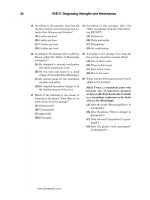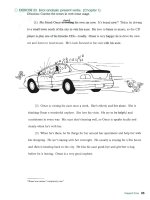Learning by doing 6 ppsx
Bạn đang xem bản rút gọn của tài liệu. Xem và tải ngay bản đầy đủ của tài liệu tại đây (61.1 KB, 6 trang )
KNOWING WHEN YOU DON’T KNOW
61
• A clear picture in your mind
• A clear sense of order
• No remaining questions in your mind
The problem is that sometimes you can think you know more than
you do. That is why it’s important to actually draw your picture and write
down the order. When you come to the point that you can’t
proceed with your drawing or list, you’ve hit the point where you should
start asking questions.
Another way to find out what you know and what you don’t is to role
play. Pretend you are the writer of your textbook, or your teacher. If you
have a study buddy (see Chapter 16, “Working with a Study Buddy”), one
of you can be the writer or teacher and the other the student. Explain to
your study buddy what you just read or heard. If you don’t have a study
buddy, explain it to yourself. Make sure you don’t leave out any steps!
When you come to any point where your explanation is unclear,
when it might not make sense to another person, you’ve found out what
you don’t know. That’s when it’s time to start asking questions. Once you
have questions, you can find the answers, and then you will know
something that you didn’t know before.
THE QUEST IS ON!
Finding what you know and then finding what you don’t know is some-
thing you already know how to do. If you were in an unfamiliar town and
wanted to get to Adams Street, you would know that you don’t know how
to get there, and you would ask directions.
Those directions would be based on what you already know—
your location at the time. You’re in the park, and you’ve been told Adams
Street is near the park, but you don’t know which direction to go. So you
ask. And someone tells you to walk north till you get to the end of the
park and then turn left and walk one block to Adams Street.
You might have one more question: Which way is north? And if
you get an answer, you’d follow those directions, walking to the end of
the park and turning left. So then you get to a street, but it doesn’t have
a street sign. How do you know if you’ve arrived? You stop someone
passing by and ask again.
1.
2.
3.
HOW TO STUDY
62
A
SKING QUESTIONS, GETTING ANSWERS
The process of asking questions to find out, first, what you already know,
and second, what you still need to learn, is similar. You might have to ask
more than one question as you find your way to the knowledge the writer
is trying to give you. Here’s a sequence you can go through to find out
what you don’t know and then ask questions and get answers. If you have
been reading a book, the text you’ll go back to for answers is the book;
if you listened to a lecture, your “text” is your notes or audiotape of
the lecture.
1. Draw a picture and write down the order.
2. Is this perfectly clear? Where are the gaps?
3. Ask yourself a question that will help fill in the gap.
4. Go back to your text to find the answer. Use the parts of your
picture or outline that are clear to help you see where in the text
you should look for the answer. Look in the sections of your text
that come right after the last clear piece of your picture or outline.
5. Read the relevant part of the text. Don’t try to re-read the whole
chapter or go over the whole lecture; you’re just looking for one
little piece of information, the answer to your question. Take it in
small chunks.
6. If you don’t have an answer, re-read the same section to try again.
7. If you still don’t have an answer, read the parts that come just
before and just after what you were reading. Repeat this process
until you find the answer to your question.
8. Put this new piece of information into your picture and order. Is
the picture clear now? Is the order clear?
9. Keep going back and forth between your study aids and the text
until your picture and order are perfectly clear, and you have no
questions left.
Now you’ve really learned something! You have a clear picture of the
main idea, and you know all the steps it takes to get there. But notice that
this clear picture and order don’t come out all at once. You have to take
it one step at a time, just as if you were following the directions to Adams
Street. And you’re always using what you know to help you find the
answers to what you don’t know.
KNOWING WHEN YOU DON’T KNOW
63
Here’s an example of how you use what you know to help you
create questions: Suppose you had to fill in the blank in the following
sentence:
When you don’t know something, your brain rushes to _____e it
has stored ideas on a similar topic.
In order to figure out what word should go in the blank, you should
go through the following process:
First ask yourself, “What do I know for sure about the sentence? “
Your responses might be:
• I know that the sentence is about recognizing when I don’t know
something.
• I know that it’s about the brain moving in some way.
• I know that there’s a storing place in my brain.
• I know that the missing word connects the brain moving to the
storage place.
• I know that the missing word ends with e.
Then ask yourself, “What kind of word would connect the brain
rushing and the storage place?” The word must have something to do
with direction. You make up more questions by connecting the words
you know that have to do with direction to the sentence:
• Is the word over? Over doesn’t end with the letter e.
• Is it here? That’s a direction word that ends in e,but here doesn’t
make sense in this sentence. Filling in that word doesn’t give you
a clear picture and a clear sense of order.
• You reject there for the same reason. The only word that really
works in the sentence—that gives a clear picture and order—is
where.
This was a simple example, but it shows you how to use what you
already know to arrive at the answers to the questions about what you
don’t know.
HOW TO STUDY
64
Choose one paragraph from a book you are studying now. Write
down the following in your notebook, or record it onto your audiotape:
• Identify what you know for sure by drawing a picture and writing
down the order.
• Find what you don’t know.
• Ask questions.
• Go through the steps listed above to find the answers.
• Write or record additional questions as they come to mind.
I
T’S A
LL YOURS
The questions that count most are your questions. You get more out of
studying; you become more involved, enjoy it more, it “sticks” more,
when you make:
• Your own observations of what you know
• Your own connections of new material to old
• Your own questions and then find your own answers!
Often, the search for answers leads to more questions. And the more
questions you ask, the clearer you’re making your answers.
YOU’RE IN COMMAND!
You’re taking control of your own learning when you:
• Recognize what you know
• Recognize what you don’t know
• Create questions to make the pictures in your head and the order
of events clear
• Discover answers to your questions
• Realize when and how to question what you’ve studied
H
OW TO
ASK QUESTIONS, DEPENDING ON YOUR
LEARNING STYLE
The most effective ways to ask questions are different for people with dif-
ferent learning styles.
KNOWING WHEN YOU DON’T KNOW
65
• If you learn best by seeing: Write or draw what you know, and
what questions you have.
• If you learn best by hearing: Read aloud as you write, and/or use
a tape recorder.
• If you learn best by images: Draw or describe the pictures and/or
maps in your head. Focus on when the pictures are unclear. Ask
questions to clear your pictures.
• If you learn best by order: Make a list and/or timeline—focus on
when that’s unclear; ask questions to develop a clearer order.
• If you learn best by doing: Imagine yourself experiencing what
you’re studying. Focus on when the experience feels unclear; ask
questions to make the experience clearer, more real.
IN SHORT
You need to know what you do know in order to find what you don’t
know. Reflect on what you’ve studied. Thinking about what you’ve read
or listened to lets you find what you know for sure, and what you don’t.
Ask yourself questions so the picture in your head is clear, and the events
are in an order that makes sense to you.
1.
2.
3.
HOW TO STUDY
66
Practice Tips
In the text you’re studying, or in a newspaper, find a word you don’t
know. Cover that word. Look at the rest of the sentence and decide
what the sentence could mean without the word you covered. If the
sentence isn’t clear on its own, write what you know for sure about the
meaning of the sentence. Try to draw a picture of the sentence, or to
make sense of it in any way that suits your learning style. Now, ask
yourself what you need to know to make the sentence clearer. Write
down your questions or record them into an audiotape.
Then go back to the original sentence and choose a word or phrase
that could replace the unfamiliar word. Check to see that your word
or phrase makes your picture clearer. You made a definition based on
what you knew—the words around the unknown word—to find out
what you didn’t know.
Now look in the dictionary and see how close you came!









